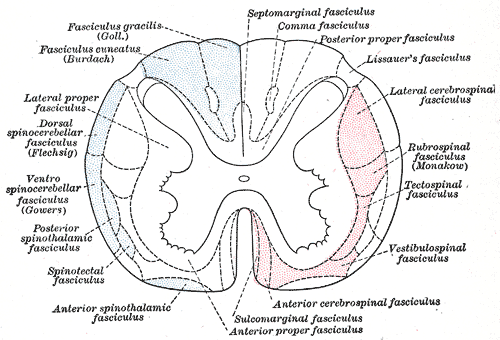2022-04-07 08:48:19
Prelude
Prelude
Announcements
- Blog 3 or paper due next Tuesday, April 12, 2022.
Today’s Topics
- The neuroscience of action, continued
Muscles
Muscle types
- Smooth
- Arteries, hair follicles, uterus, intestines
- Regulated by ANS (involuntary)
- Striated (striped)
- Skeletal muscles
- Voluntary control, mostly connected to tendons and bones
- Regulated by somatic branch of PNS
- Cardiac
Muscle types
How skeletal muscles contract
- Motoneuron (in ventral horn of spinal cord) ->
- Neuromuscular junction
- Releases ACh
From spinal cord to muscle
How skeletal muscles contract
- Motor endplate
- Contains nicotinic ACh receptor
- Generates excitatory endplate potential (EPP)
- Muscle fiber depolarizes
- Depolarization spreads along fiber
- Causes release of Ca++ from stores inside muscle
Motor endplate
Anatomy of motor endplate
How skeletal muscles contract
- Muscle fibers segmented in to sarcomeres
- Myofibrils (w/in sarcomere)
- Paired actin & mysosin proteins
- “Molecular gears”
- Bind, move, unbind in presence of Ca++ plus energy source (ATP)
Anatomy of muscle fibers
Agonist/antagonist muscle pairs
Meat preference?
Muscle fiber types
- Fast twitch/fatiguing
- Type II
- White meat
- Slow twitch/fatiguing
- Type I
- Red meat
Muscles are sensory organs, too!

Two muscle fiber types
Two muscle fiber types
- Intrafusal fibers
- Sense length/tension
- Contain muscle spindles linked to Ia afferents
- ennervated by gamma (\(\gamma\)) motor neurons
- Extrafusal fibers
- Generate force
- ennervated by alpha (\(\alpha\)) motor neurons
Monosynaptic stretch (myotatic) reflex
- Muscle stretched (length increases)
- Muscle spindle in intrafusal fiber activates
- Ia afferent sends signal to spinal cord
- Activates alpha (\(\alpha\)) motor neuron
- Muscle contracts, shortens length
Monosynaptic stetch (myotatic) reflex
- Gamma (\(\gamma\)) motor neuron fires to take up intrafusal fiber slack
https://www.nytimes.com/2020/11/09/sports/emily-harrington-free-climb-yosemite.html
Monosynaptic stretch (myotatic) reflex
Why doesn’t antagonist muscle respond?
Why doesn’t antagonist muscle respond?
- Polysynaptic inhibition of antagonist muscle
- Prevents/dampens tremor
Brain gets fast(est) sensory info from spindles
How the brain controls the muscles
- Pyramidal system
- Pyramidal cells (from Cerebral Cortex Layer 5) in primary motor cortex (M1)
- Corticobulbar (cortex -> brainstem) tract
- Corticospinal (cortex -> spinal cord) tract
- Crossover (decussate) in medulla
- L side of brain ennervates R side of body
Corticospinal tract
How the brain controls the muscles
- Extrapyramidal system
- Tectospinal tract
- Vestibulospinal tract
- Reticulospinal tract
- Involuntary movements
- Posture, balance, arousal
Extrapyramidal system
This figure shows that the descending motor pathways in red on the right have their own spatial organization depending on where they originate in the brain.
Disorders
- Parkinson’s
- Huntington’s
The Faces of Parkinson’s
Parkinson’s
- Symptoms
- Slow, absent movement, resting tremor
- Cognitive deficits, depression
- Biological correlates
- DA neurons in substantia nigra degenerate
- Autoimmune disorder? (Garretti, Agalliu, Lindestam Arlehamn, Sette, & Sulzer, 2019)
Parkinson’s
- Treatments
- DA agonists
- DA agonists linked to impulse control disorders in ~1/7 patients (Ramirez-Zamora, Gee, Boyd, & Biller, 2016)
- Levodopa (L-Dopa), DA precursor
- Deep brain stimulation
Huntington’s
Huntington’s
- Formerly Huntington’s Chorea
- “Chorea” from Greek for “dance”
- “Dance-like” pattern of involuntary movements
- Cognitive decline
Huntington’s
Huntington’s
- Genetic + environmental influences
- Gene fragment (CAG) duplication
- High levels of huntingtin protein accumulate in basal ganglia
- People with familial risk may want to consider genetic testing
- No effective treatment
- Promising gene therapy trial halted last year (Kwon, 2021)
Final thoughts
- Control of movement determined by multiple sources
- Cerebral cortex + basal ganglia + cerebellum + spinal circuits
Next time…
- Vision
References
Garretti, F., Agalliu, D., Lindestam Arlehamn, C. S., Sette, A., & Sulzer, D. (2019). Autoimmunity in parkinson’s disease: The role of \(\alpha\)-Synuclein-Specific T cells. Frontiers in Immunology, 10, 303. https://doi.org/10.3389/fimmu.2019.00303
Kwon, D. (2021). Failure of genetic therapies for huntington’s devastates community. Nature, 593(7858), 180. https://doi.org/10.1038/d41586-021-01177-7
Ramirez-Zamora, A., Gee, L., Boyd, J., & Biller, J. (2016). Treatment of impulse control disorders in Parkinson’s disease: Practical considerations and future directions. Expert Review of Neurotherapeutics, 16(4), 389–399. https://doi.org/10.1586/14737175.2016.1158103






